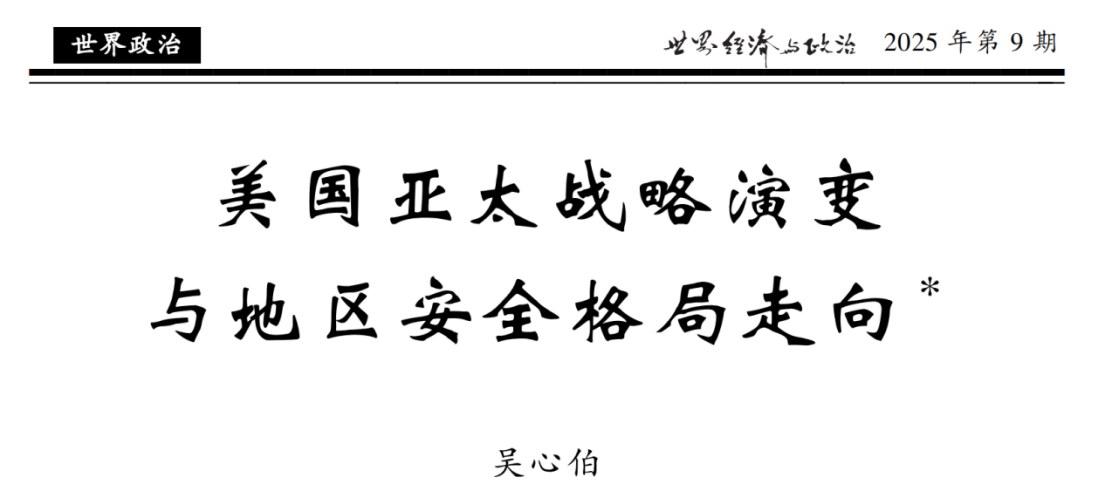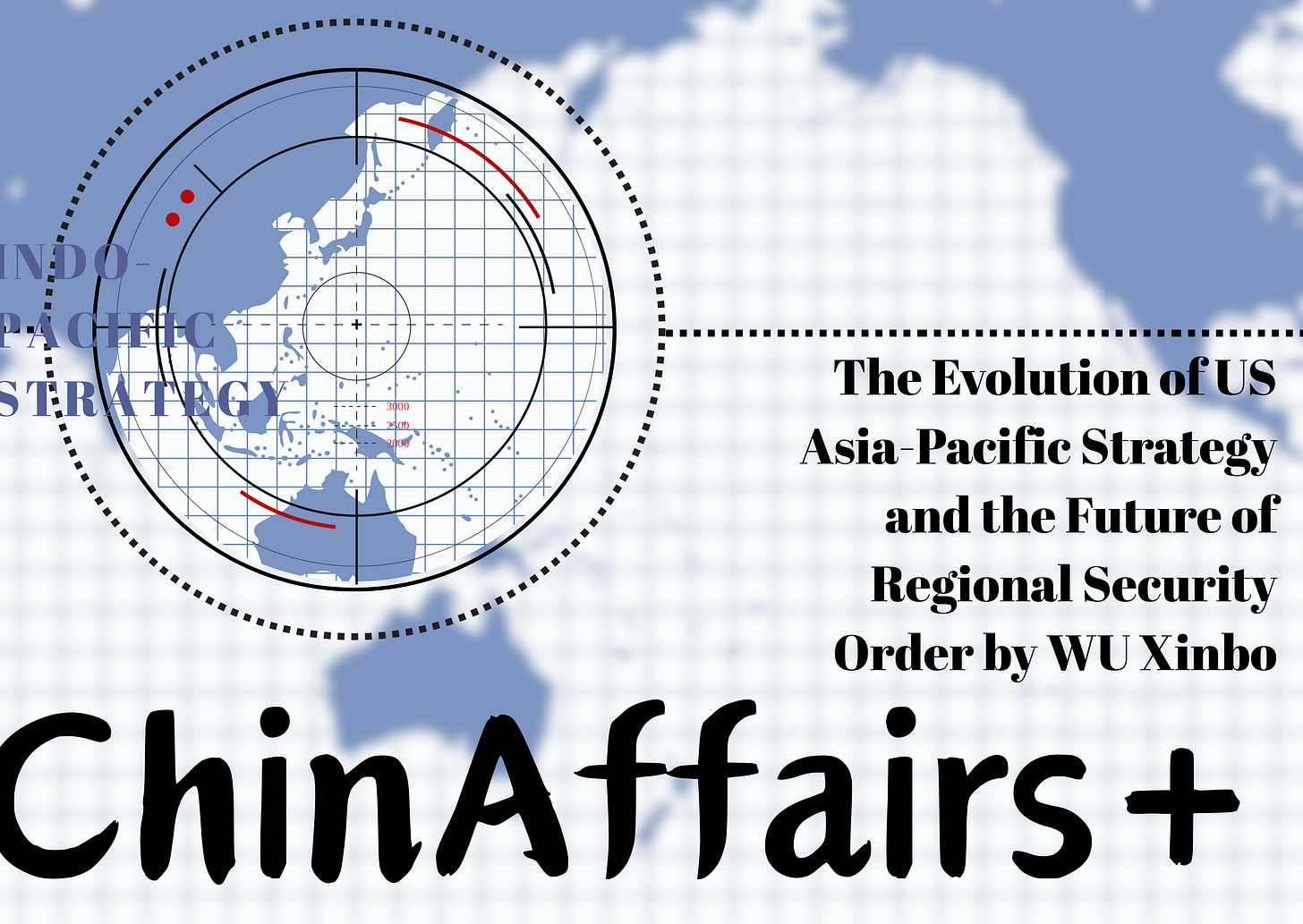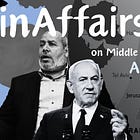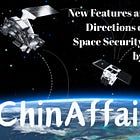WU Xinbo: The Evolution of US Asia-Pacific Strategy and the Future of Regional Security Order
This round of structural adjustment is accompanied by rising geopolitical tensions and mounting security risks.
Welcome to the 59th edition of our weekly newsletter! I’m SUN Chenghao, a fellow with the Center for International Security and Strategy (CISS) at Tsinghua University, Council Member of The Chinese Association of American Studies and a visiting scholar at the Paul Tsai China Center of Yale Law School (fall 2024).
ChinAffairsplus is a newsletter that shares articles by Chinese academics on topics such as China’s foreign policy, China-U.S. relations, China-Europe relations, and more. This newsletter was co-founded by my research assistant, ZHANG Xueyu, and me.
Through carefully selected Chinese academic articles, we aim to provide you with key insights into the issues that China’s academic and strategic communities are focused on. We will highlight why each article matters and the most important takeaways. Questions and feedback can be addressed to sch0625@gmail.com
Today, we have selected an article written by Wu Xinbo, which focuses on the US Asia-Pacific Strategy.
Summary
After identifying China as the primary target of its Asia-Pacific strategy, the Obama administration focused on the rise of China’s geopolitical influence in the Asia-Pacific region, with its Asia-Pacific strategy featuring prominent checks and balances. The first Trump administration was concerned about the growth of China’s military strength, and its Asia-Pacific strategy emphasized suppression and containment. The Biden administration was more focused on the “challenges” China posed to U.S. security interests in the Asia-Pacific region, with its strategic posture highlighting deterrence.
Since the Obama administration, driven by an aggressive stance and relatively weak power in the region, the U.S. has adopted an expansive alliance strategy, expanding its traditional alliance system into an alliance-partner network. Ongoing Asia-Pacific security transformations feature diversified actors, multiple checks and balances, increased interactivity, and the rising importance of Asian countries. The future of regional security depends largely on China-U.S. relations: conflict would bring long-term binary confrontation; strategic understanding would further develop a diversified landscape with cooperation, hedging and competition.
Why It Matters
After identifying China as the primary target of its Asia-Pacific strategy, the Obama administration focused on the rise of China’s geopolitical influence in the Asia-Pacific region, with its Asia-Pacific strategy featuring prominent checks and balances. The first Trump administration was concerned about the growth of China’s military strength, and its Asia-Pacific strategy emphasized suppression and containment. The Biden administration was more focused on the “challenges” China posed to U.S. security interests in the Asia-Pacific region, with its strategic posture highlighting deterrence.
Since the Obama administration, driven by an aggressive stance and relatively weak power in the region, the U.S. has adopted an expansive alliance strategy, expanding its traditional alliance system into an alliance-partner network. Ongoing Asia-Pacific security transformations feature diversified actors, multiple checks and balances, increased interactivity, and the rising importance of Asian countries. The future of regional security depends largely on China-U.S. relations: conflict would bring long-term binary confrontation; strategic understanding would further develop a diversified landscape with cooperation, hedging and competition.
Key Points
1. The U.S. Asia-Pacific Strategy in the Context of the United States’ Strategic Competition with China
(1)Competitive Means to Address Security Challenges
Balancing, containment or suppression, and deterrence are three progressive levels of competitive means to address security challenges. When its security interests are under threat, the United States mainly resorts to means such as containment, deterrence, and war; when its superiority in military strength is challenged, the United States often spares no effort to contain and suppress its rivals; when its international influence is weakened, the United States mainly implements comprehensive measures in diplomacy, security, and economy to check and balance its rivals.
(2)The Obama Administration
During the Obama administration, the U.S. was mired in the Afghan and Iraqi wars and the 2008 financial crisis, paying insufficient attention to the Asia-Pacific and seeing its own strength decline. China’s geopolitical influence rose along with its rapid economic growth and East Asian regional cooperation, which the Obama administration focused on. It launched the “Asia-Pacific Rebalance” strategy to balance China via more diplomatic, economic and strategic investment in the Asia-Pacific region, and security cooperation with Asian partners, avoiding direct confrontation.
(3)The Trump Administration
During the Trump administration’s first term, it focused on the growth of China’s military strength, with its Asia-Pacific strategy emphasizing suppression and containment, emphasizing confrontation. Though it launched the “Indo-Pacific Strategy” under allies’ lobbying, its core focus remained on the Asia-Pacific and China. It increased military involvement in the South China Sea via “freedom of navigation” operations to curb China’s strength, and promoted a “networked security architecture,” notably organizing the U.S.-Japan-India-Australia “Quadrilateral Security Dialogue”.
(4)The Biden Administration
During the Biden administration, the U.S. focused on the “challenge” posed by China to U.S. security interests in the Asia-Pacific, with its Asia-Pacific strategy highlighting deterrence. It proposed the concept of “integrated deterrence” and launched the “Pacific Deterrence Initiative” to enhance military capabilities and cooperation with allies, with a focus on the Taiwan Strait. The Biden administration’s strategy marks the first time since the Cold War the U.S. has explicitly taken a major strategic-level power as the primary target of its regional strategy, and the first time since the 1970s that the U.S. has regarded China as its Asia-Pacific rival most likely to trigger military conflict. The U.S. has expanded its military capabilities accordingly.
2. From an Alliance System to an Alliance-Partner Network
(1) Adjustments to the U.S. Asia-Pacific Alliance Strategy After the Cold War
After the Cold War, the U.S. Asia-Pacific alliance strategy initially maintained the traditional “hub-and-spoke” system. From the Clinton and George W. Bush administrations, this system was characterized by absolute U.S. dominance, one-way obligations, and a single structure, with no major strategic adversaries at that time. From the Obama to Biden administrations, the U.S. began to adjust its alliance strategy due to changes in the balance of power and the increased autonomy of its allies. The U.S. started to encourage Japan to strengthen its military capabilities, reform its national security mechanisms, enhance U.S.-Japan security cooperation, and increase investment in the U.S.-Japan alliance as well as actively advocate for and advance the “Indo-Pacific Strategy”. The U.S.-Japan alliance transformed into a model of “US-led with Japan as assistant”, shifting from a defensive nature to an offensive one centered on balancing, containing, and deterring China.
(2) Networking and the Construction of a New Alliance-Partner System
An important change in the U.S. Asia-Pacific alliance strategy is reflected in the development of networking and the construction of a new alliance-partner system. The U.S. has expanded its bilateral cooperation with regional allies to trilateral cooperation, promoted institutionalized cooperation using the “U.S. + allies + security partners” model, and strengthened the connections between allies as well as between allies and security partners. Compared with the traditional alliance system, the new alliance-partner system is characterized by a complex structure, the increased importance of allies and security partners, and the relative decline in the dominance of the U.S. position.
(3) The Impacts of the Changes in the U.S. Asia-Pacific Alliance Strategy
The changes in the U.S. Asia-Pacific alliance strategy have had two key impacts: strengthening the empowerment of its allies and security partners, and shifting its Asia-Pacific strategy from an advantage strategy to a balance of power strategy.
The future of this strategy mainly depends on regional strategic posture and national strength. Different combinations of the two shape four alliance strategies. A proactive strategic posture combined with a high national strength will give rise to a tight alliance strategy; a proactive strategic posture combined with low strength will give rise to an expansive alliance strategy; a status-quo maintenance strategic posture combined with high strength will give rise to a loose alliance strategy; and a status-quo maintenance strategic posture combined with low strength will give rise to a laissez-faire alliance strategy. Since the Obama administration, the U.S. has mainly pursued the expansive alliance strategy.
3. The Future Direction of the Asia-Pacific Regional Security Order
(1) Changes in the Asia-Pacific Regional Security Landscape in Recent Decades
After the end of the Cold War, the Asia-Pacific security landscape has evolved toward a pluralistic power structure, and the interactions among major actors have been characterized by non-confrontation and cooperation. The United States’ dominance has begun to decline, while the roles of Asian actors such as China and ASEAN have become more prominent. Since the second decade of the 21st century, China’s rapid development, the adjustment of the U.S. Asia-Pacific strategy, and the responses of relevant countries to these changes have been driving a new round of profound changes in the Asia-Pacific security landscape.
From the perspective of power distribution, the Asia-Pacific security landscape has become increasingly characterized by pluralism. China, Japan, ASEAN, North Korea, and India have all seen an increase in their influence.
From the perspective of interaction patterns, multiple checks and balances are emerging in the Asia-Pacific region. First, there are checks and balances by China against the United States. Second, there are checks and balances by the United States against China. Third, there are checks and balances by other countries against China. These multiple checks and balances have also endowed the regional security order with dynamic characteristics.
Changes in the balance of power and multiple checks and balances have led to increased security interactions in the Asia-Pacific. Since the Obama administration, interactions between the United States and its allies and security partners, interactions among U.S. allies themselves, and interactions between U.S. allies and its security partners have all increased significantly. Currently, the growing security interactions in the Asia-Pacific are, on the whole, more competitive than cooperative, and their negative effects on regional security outweigh the positive ones.
(2) Factors Influencing the Asia-Pacific Regional Security Landscape and Their Effects
As more and more actors seek to participate in shaping the Asia-Pacific security landscape, the importance of Asian countries has been on the rise. These countries are more sensitive to conflicts in the region, and the enhancement of their ability to shape the regional security landscape is more conducive to promoting regional stability.
The trajectory of the Asia-Pacific security landscape is also influenced by geoeconomic factors. Some regional countries seek to strengthen economic relations with China, while others do not want their economic and trade relations with China to be severely damaged. Consequently, economic factors have affected the regional security policy orientations of relevant countries.
The future trajectory of the Asia-Pacific security landscape fundamentally depends on China-U.S. relations: If China and the United States move toward a major conflict, the regional security landscape will turn into one of binary confrontational model for a relatively long period, characterized mainly by division and confrontation; if China and the United States reach a new strategic understanding, a pluralistic regional security landscape featuring the coexistence of multiple actors and a mix of interaction patterns—including cooperation, hedging, and competition—will further develop.
Conclusion
The security landscape in the Asia-Pacific region undergoes a major transformation approximately every 20 years. This round of structural adjustment is accompanied by rising geopolitical tensions and mounting security risks.
During Trump’s second term, the basic posture of the U.S. Asia-Pacific strategy will remain unchanged: its Secretary of Defense and diplomatic team will continue to emphasize joining hands with Asia-Pacific allies to respond to “the China Threat”, uphold the concept of “peace through strength,” rebuild the deterrence capability of the U.S. military, and designate the Indo-Pacific as a strategic priority area. However, the advancement of this strategy is fraught with uncertainties due to three factors: developments in the situations in Europe and the Middle East will determine U.S. resource allocation in the Asia-Pacific; the state of alliance relations may be weakened by changes in U.S. policies and the domestic political dynamics of allied countries; the direction of China-U.S. relations means that while maintaining strategic deterrence against China, the U.S. needs to weigh the choice between active deterrence and passive deterrence. These uncertainties imply that the regional security landscape will present two distinct prospects: a further escalation of tensions or a moderate easing of strains.
About the Author
WU Xinbo: Dr. WU Xinbo is Professor and Dean at the Institute of International Studies, and Director at the Center for American Studies at Fudan University. Dr. WU serves on the policy advisory board of the Chinese Ministry of Foreign Affairs. He is on the editorial board of The Washington Quarterly, European Journal of International Security and on the International Advisory Board of International Affairs. He is currently a member on the Advisory Council of Asia Society Policy Institute, as well as a member of The Trilateral Commission.
About the Publication
The Chinese version of this article was published in World Economics and Politics(《世界经济与政治》). This journal, founded in 1987, is an academic and theoretical journal supervised by the Chinese Academy of Social Sciences (CASS) and sponsored by the Institute of World Economics and Politics under CASS. It reflects research findings in the fields of world economy and international politics. The journal focuses on analyzing global economic trends and changes in the political landscape, providing insights into issues related to international politics, economy, diplomatic relations, and military affairs. Additionally, it explores the general principles and methodologies for researching topics in international relations and international politics.











